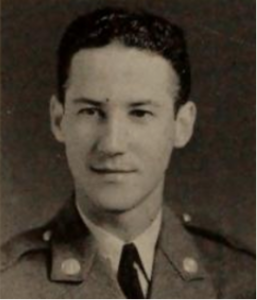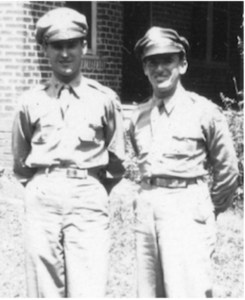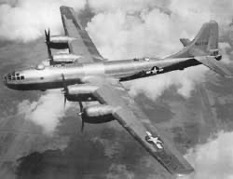Scroll of Honor – Vallentin Tulla
Superfortress Pilot
Written by: Kelly Durham
It was described as a technological marvel, a quantum leap forward in aviation science and engineering.  The B-29 Superfortress very heavy bomber demonstrated the ingenuity and capability of American science and engineering under the grave pressures of a world at war. Even before the war began, the Army Air Corps realized that the B-17 Flying Fortress would not be adequate for the vast distances encompassed by the Pacific theater. To fulfill anticipated mission requirements, the Air Corps required a new, very heavy bomber that could carry greater bomb loads longer distances at higher altitudes and at greater speeds. Boeing Aircraft’s answer was the B-29, at $3 billion the most expensive weapons system ever developed, surpassing even the Manhattan Project with which it would be inevitably linked. One of the pilots training to fly this modern marvel was Vallentin Tulla, Clemson College Class of 1943.
The B-29 Superfortress very heavy bomber demonstrated the ingenuity and capability of American science and engineering under the grave pressures of a world at war. Even before the war began, the Army Air Corps realized that the B-17 Flying Fortress would not be adequate for the vast distances encompassed by the Pacific theater. To fulfill anticipated mission requirements, the Air Corps required a new, very heavy bomber that could carry greater bomb loads longer distances at higher altitudes and at greater speeds. Boeing Aircraft’s answer was the B-29, at $3 billion the most expensive weapons system ever developed, surpassing even the Manhattan Project with which it would be inevitably linked. One of the pilots training to fly this modern marvel was Vallentin Tulla, Clemson College Class of 1943.

Vallentin Tulla, left, and Jesus Bardia were both members of the Class of 1943, both from Puerto Rico, both Army Air Force pilots, and are both listed on the Scroll of Honor.
In an era in which more than eighty percent of Clemson’s upper classmen were from South Carolina, Tulla was a rarity. He wasn’t a Palmetto State native, nor was he from the continental United States. Tulla was from Santurce, Puerto Rico, one of five upper classmen from the island attending Clemson in 1942. Tulla was a civil engineering major and a member of the Newman Club, the Catholic students’ organization. Tulla left Clemson at the end of his junior year in the spring of 1942. He volunteered for the Army Air Force, perhaps eager to put his engineering skills to use.
Tulla advanced through the phases of flight training and qualified as pilot on the B-17, the Army Air Force’s workhorse heavy bomber. He was assigned to the 501st Bomb Group, activated June 1, 1944 at Dalhart, Texas. The 501st would transition to the new, state-of-the-art B-29 Superfortress. In August, the Group moved to Harvard Army Airfield in Nebraska. In November, air crews were formed for the transition training to begin. Long distance flights were part of the training regimen as the B-29s would undertake long-range missions from Pacific Islands like Tinian to attack Japan’s home islands some fifteen hundred miles distant.
On March 12, 1945, Tulla was the pilot for a navigational training flight that departed Harvard at 1025 Central War Time. The aircraft carried a full crew and was scheduled to remain airborne for fourteen hours, simulating the length of a round trip mission.
The urgency of the war and the need to field a bomber that could reach Japan from the greatest possible distance rushed the development of the B-29. Its advanced design and challenging specifications inevitably resulted in setbacks. The second prototype of the big bomber had experienced an engine fire on its very first flight on December 30, 1942. Less than two months later, the prototype was back in the skies, having lifted off from Seattle’s Boeing Field with chief test pilot Eddie Anderson at the controls. Once again, an engine caught fire, but this time the results were fatal. All eleven aboard the aircraft were killed, along with twenty workers and a fireman when the plane crashed into a Seattle meat-packing plant.
the greatest possible distance rushed the development of the B-29. Its advanced design and challenging specifications inevitably resulted in setbacks. The second prototype of the big bomber had experienced an engine fire on its very first flight on December 30, 1942. Less than two months later, the prototype was back in the skies, having lifted off from Seattle’s Boeing Field with chief test pilot Eddie Anderson at the controls. Once again, an engine caught fire, but this time the results were fatal. All eleven aboard the aircraft were killed, along with twenty workers and a fireman when the plane crashed into a Seattle meat-packing plant.
Despite its sleek appearance and modern design, the B-29 continued to experience engine problems. Engineering changes were being designed so rapidly that aircraft came off of the production lines and were immediately flown to modification centers for continued adjustments. The most common problem with the advanced aircraft continued to be catastrophic engine failure.
Ten hours into the flight, Second Lieutenant Tulla radioed the control tower at Alexandria, Louisiana stating that he was coming in for an emergency landing due to engine trouble. The tower granted an emergency clearance, but according to the subsequent accident report, an engine backfire sucked fire into the aircraft’s induction system. The aircraft veered to the left of the runway and dropped steeply, resulting in a cartwheeling crash, explosion, and fire. All ten aboard the aircraft were killed.
Vallentin Tulla was survived by his wife, the former Betty Goodman of Clemson, his parents, two brothers and four sisters. His sister, Haydee Tulla, then a graduate student at the University of Pennsylvania, attended her brother’s burial service at Clemson’s Old Stone Church Cemetery. After the war, Tulla’s remains were returned to Puerto Rico and buried at the Puerto Rico Memorial in Carolina.
For additional information on Vallentin Tulla see:
https://soh.alumni.clemson.edu/scroll/valentin-tulla/
For more information about Clemson University’s Scroll of Honor visit:

